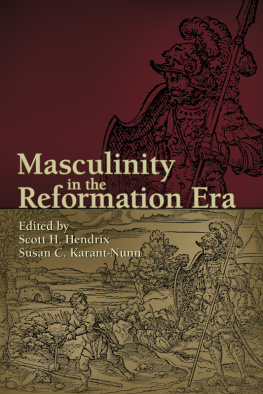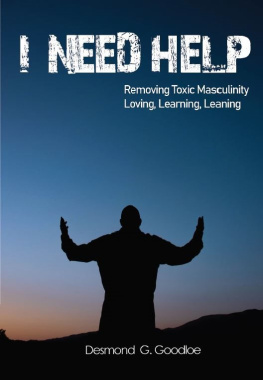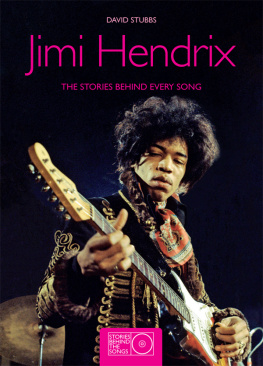Scott H. Hendrix - Masculinity in the Reformation Era
Here you can read online Scott H. Hendrix - Masculinity in the Reformation Era full text of the book (entire story) in english for free. Download pdf and epub, get meaning, cover and reviews about this ebook. year: 2012, publisher: PennStateUP, genre: Romance novel. Description of the work, (preface) as well as reviews are available. Best literature library LitArk.com created for fans of good reading and offers a wide selection of genres:
Romance novel
Science fiction
Adventure
Detective
Science
History
Home and family
Prose
Art
Politics
Computer
Non-fiction
Religion
Business
Children
Humor
Choose a favorite category and find really read worthwhile books. Enjoy immersion in the world of imagination, feel the emotions of the characters or learn something new for yourself, make an fascinating discovery.
- Book:Masculinity in the Reformation Era
- Author:
- Publisher:PennStateUP
- Genre:
- Year:2012
- Rating:4 / 5
- Favourites:Add to favourites
- Your mark:
- 80
- 1
- 2
- 3
- 4
- 5
Masculinity in the Reformation Era: summary, description and annotation
We offer to read an annotation, description, summary or preface (depends on what the author of the book "Masculinity in the Reformation Era" wrote himself). If you haven't found the necessary information about the book — write in the comments, we will try to find it.
Masculinity in the Reformation Era — read online for free the complete book (whole text) full work
Below is the text of the book, divided by pages. System saving the place of the last page read, allows you to conveniently read the book "Masculinity in the Reformation Era" online for free, without having to search again every time where you left off. Put a bookmark, and you can go to the page where you finished reading at any time.
Font size:
Interval:
Bookmark:
Masculinity in the Reformation Era
Habent sua fata libelli
S IXTEENTH C ENTURY E SSAYS & S TUDIES S ERIES
G ENERAL E DITOR
Michael Wolfe
St. Johns University
E DITORAL B OARD OF S IXTEENTH C ENTURY E SSAYS & S TUDIES
Elaine Beilin
Framingham State College
Christopher Celenza
Johns Hopkins University
Miriam U. Chrisman
University of Massachusetts, Emerita
Barbara B. Diefendorf
Boston University
Paula Findlen
Stanford University
Scott H. Hendrix
Princeton Theological Seminary
Jane Campbell Hutchison
University of WisconsinMadison
Robert M. Kingdon
University of Wisconsin, Emeritus
Ronald Love
University of West Georgia
Mary B. McKinley
University of Virginia
Raymond A. Mentzer
University of Iowa
Helen Nader
University of Arizona
Charles G. Nauert
University of Missouri, Emeritus
Sheryl E. Reiss
Cornell University
Robert V. Schnucker
Truman State University, Emeritus
Nicholas Terpstra
University of Toronto
Margo Todd
University of Pennsylvania
James Tracy
University of Minnesota
Merry WiesnerHanks
University of WisconsinMilwaukee
Masculinity in the Reformation Era
Edited by
Scott H. Hendrix
Susan C. Karant-Nunn
Sixteenth Century Essays & Studies 83
Truman State University Press
Kirksville, Missouri
Copyright 2008 Truman State University Press, Kirksville, Missouri USA
All rights reserved
tsup.truman.edu
Cover art: Virgil Solis, David and Goliath, ca. 1562. Woodcut, from Veit Dietrich, Summaria vber die gantze Biblia (Frankfurt a.M.: David Zepheln, Johan Raschen, & Sigmund Feierabend, 1562). Image courtesy of the Kessler Reformation Collection, Pitts Theology Library, Candler School of Theology, Emory University, Atlanta, Georgia.
Cover design: Teresa Wheeler
NOTE: Because of display limitations of e-readers, some special characters (e.g., accents or other diacritical marks, cedillas, characters in Eastern European languages, Greek or Hebrew letters) may not display properly in the e-book version of this work.
Library of Congress Cataloging-in-Publication Data
Masculinity in the Reformation era / edited by Scott H. Hendrix, Susan C. Karant-Nunn.
p. cm. (Sixteenth century essays & studies ; v. 83)
Includes index.
ISBN 978-1-931112-76-5 (hardback : alk. paper) ISBN 978-1-935503-53-8 (ebook)
1. MasculinityEuropeHistory. 2. MasculinityReligious aspectsChristianityHistory. 3. ReformationEurope. 4. EuropeHistory14921648. 5. Social change. I. Hendrix, Scott H. II. Karant-Nunn, Susan C.
HQ1090.7.E85M37 2008
305.3109409'031dc22
2008008655
No part of this work may be reproduced or transmitted in any format by any means without written permission from the publisher.
Contents
Dimensions of Manhood
Scott H. Hendrix and Susan C. Karant-Nunn
Part One: Deviating from the Norms
Negotiating Masculinity in Early Modern Northwestern Spain
Allyson M. Poska
A Case Study
Helmut Puff
Ignatius of Loyola and the Reformation of Masculinity
Ulrike Strasser
Scott H. Hendrix
Part Two: Civic and Religious Duties
Concepts of Masculinity in Reformation Geneva
Karen E. Spierling
Raymond A. Mentzer
B. Ann Tlusty
Part Three: The Man Martin Luther
Theory, Practicality, and Humor
Susan C. Karant-Nunn
Male Libido in the Writings of the Reformer
Merry E. Wiesner-Hanks
Acknowledgments
This book is the expanded product of sessions organized by the editors for the annual meeting of the Sixteenth Century Society and Conference (formerly the Sixteenth Century Studies Conference). Scholars of the Reformation era whose research concentrates on different parts of Europe were asked to reflect on ways in which masculinity was constructed and expressed in the areas they studied. The sessions were held at three successive conferences in 2002, 2003, and 2004, and we thank the Society for allowing us to include these sessions in their programs. We are grateful to all the scholars invited to prepare papers for agreeing to publish their revised essays in this collection.
The editors are among those who contributed papers to those sessions. The essay by Scott Hendrix that appears in this collection, Masculinity and Patriarchy in Reformation Germany, is reprinted from the Journal of the History of Ideas 56 (1995). We thank the editors of the Journal and its publisher, Johns Hopkins University Press, for allowing the article to be reprinted here.
We also invited two other scholars of early modern Europe, Helmut Puff and Merry E. Wiesner-Hanks, to contribute essays on masculinity to our collection. The essay by Professor Wiesner-Hanks, 'Lustful Luther': Male Libido in the Writings of the Reformer, was originally published in Sexuality and Culture in Medieval and Renaissance Europe, edited by Philip M. Soergel (Studies in Medieval and Renaissance History 3/2, New York: AMS Press, 2005). We extend our appreciation to AMS Press for allowing her essay to be reprinted in this collection. We also thank Sandra Kimball at the University of Arizona for her ongoing assistance, including the preparation of this manuscript. Her intelligent, watchful labors made it possible for Professor Karant-Nunn to take on activities that she otherwise could not have done.
Scott H. Hendrix
Susan C. Karant-Nunn
Introduction
Dimensions of Manhood
Scott H. Hendrix and Susan C. Karant-Nunn
If the first generation of researchers after 1970 discovered many facets of womens history, including the multitude of ways in which European societies attempted to shape girls into the kinds of women they wanted, the second generation has also noted the ways in which those societies formed boys into men. Initially uneasy about seeming to revert to telling the stories of males, scholars are now exploring the simultaneous efforts to craft both sexes into adults who would conform to normative ideals of femininity and masculinity to which late medieval and early modern rural communities, towns, and noble courts aspired. Apropos of early modern Europe, Claudia Opitz has described how our pioneering colleagues gradually departed from an exclusive search for past womens lives in favor of examining the interactive forces of women and men in their class-based variations. She traces the development of the innovative, useful category of gender, introduced by thinkers like Gerda Lerner, Gisela Bock, and Joan Scott. No later than the early 1990s, the search was on in North America and Great Britain for the formative and constitutive elements of masculinity, and that endeavor has quickly spread to the rest of Europe. It has entailed the study of being-a-man from an entirely new perspective, one that could draw inspiration from the ethnographic scrutiny of other societies.
The fundamental insight that expectations of women equally entail understandings of manhood has become ubiquitous, and the examples multiply apace. Among the earliest in this country was Clare Lees anthology, Medieval Masculinities. Levys insight that they have a nullifying effect on the women portrayed could be applied to Robert Schumanns song-cycle, Frauenliebe und Leben, and most especially to the song, Nun hast Du mir den ersten Schlag getan. With the husbands death, the wife in some sense, and certainly in her own eyes, has ceased to exist.
In English literature, Lynn Enterline and Mark Breitenberg have been early theorists of masculinity. This point is invaluable.
We take inspiration from these scholars and from the many others who have preceded us. As historians who have concentrated largely on the sixteenth-century religious movements that are collectively referred to as the Reformation, we recognize that Reformation specialists were for a while hesitant to take up research on women in relation to the new confessions and that more recently they have been equally cautious about pursuing Protestant definitions of manliness. Over the last twenty-five years, however, historians have not confined themselves to studying prominent religious women like Katharina von Bora, While much about the lives of early modern women remains to be investigated, a respectable beginning has been made.
Next pageFont size:
Interval:
Bookmark:
Similar books «Masculinity in the Reformation Era»
Look at similar books to Masculinity in the Reformation Era. We have selected literature similar in name and meaning in the hope of providing readers with more options to find new, interesting, not yet read works.
Discussion, reviews of the book Masculinity in the Reformation Era and just readers' own opinions. Leave your comments, write what you think about the work, its meaning or the main characters. Specify what exactly you liked and what you didn't like, and why you think so.










